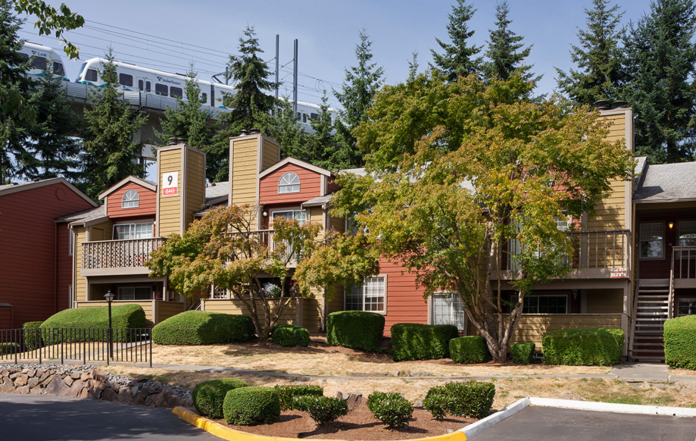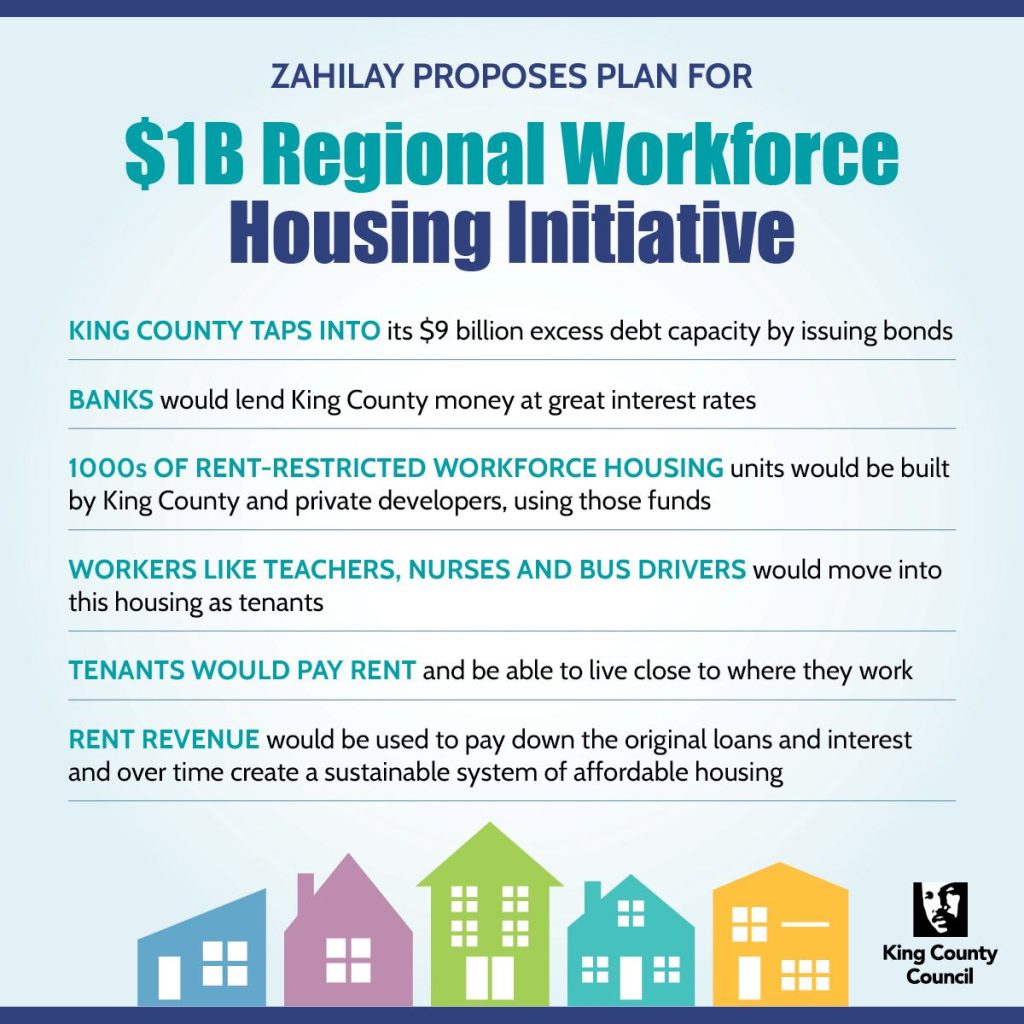
The King County Council is mulling a large bond for workforce housing, how exactly to guarantee the bonds and structure the program remains unclear.
On Tuesday, the King County Council’s budget committee greenlit a proposal directing the County Executive to study the feasibility of issuing a billion dollars in County bonds to fund the construction of workforce housing. The motion will go to the full county council for a final vote. If approved, the motion would task Executive Dow Constantine’s office with conducting the analysis and sketching out the initiative.
Under the banner of the Regional Workforce Housing Initiative, Councilmember Girmay Zahilay brought forward the proposal last month, touting the potential to create a revolving fund to create thousands of homes that are affordable to the working class.
“The initiative is a bold step forward in addressing the region’s housing crisis by directing King County to develop an implementation plan that utilizes at least $1 billion of our county’s excess debt capacity to partner with housing agencies and developers in creating permanently rent-restricted, multiple-unit housing for the region’s workforce,” Zahilay wrote in his latest newsletter. “Rents for these units would be set to reflect the true cost of development and operation. The motion also prioritizes fair labor practices and King County’s high environmental standards.”

Councilmember Claudia Balducci raised questions about financial risk and how to guarantee the bonds without jeopardizing the County’s core finances. She noted the County’s general fund is already strained and facing big deficits in the years ahead, even before accounting for new obligations.
“We are facing already $150 million hole in our general fund next year,” Balducci said. “That translates, if we don’t do anything to change the trajectory of that, into something like 400 positions lost in our general fund agencies.”
Balducci pushed back against the concept of using the County’s general fund as the fallback source to ensure the bonds if rent revenue prove insufficient.
“I think it is reckless — I’ll use the word reckless — for us to take a position here today, before we get the feasibility information back that we’re asking for with this motion, that we shall do this. And this motion is meant to say we should get the information back, see what it says, and then decide what we will do.”
Zahilay countered that the motion was not binding and the one billion dollars language was intended to be encouragement rather than the final word on the matter.
“I wrote this so that we can encourage the executive to swing for the fences in addressing our housing crisis, to try to meet the problem scale of the problem,” Zahilay said. “If the executive does an implementation plan and a feasibility assessment and does all the risk analysis that this motion is directing to do, and he comes back and says, actually, a billion dollars is not feasible. Actually, the risk assessment that we are conducting tells us that the risk is too high to do this in the current environment. There’s nothing in this motion that binds him to do that, because, again, it’s a motion.”
Nonetheless, the councilmembers discussed how the way the billion-dollar bond branding that Zahilay has leaned into in promoting his initiative could set expectations with the public that ultimately are hard to break — at least if they’re not clear about the hurdles to clear.
“I just want to emphasize that I think everybody here, as I understand it, understands that we are not committing to doing this until we get the report back from the executive,” Councilmember Jorge Barón said.
Zahilay is hoping to produce reasonably-priced multi-bedroom homes to serve a major gap in the market. The initiative would seek to work with existing public housing authorities in the county and create mixed-income buildings, with the vision that rents, especially from the portion of tenants with incomes near the county median, could create a revenue stream that pays off bonds. In fact, if all goes well, Zahilay hopes that rents could not just pay off the bond and cover operations, but also create an ongoing revenue source for more housing construction within the program.
It’s a similar model as House Our Neighbors is pursuing with the Seattle Social Housing Developer, which will have a funding stream on the ballot in February via a special election — though Zahilay has not used the term “social housing.”
Zahilay and initiative co-sponsor Rod Dembowski raised the issue that Balducci’s change could potentially delay the timeline for the housing bond. Ultimately, discussion between staff and councilmembers determined that little if any delay would result since bonding already requires a council vote to formally issue.
“I’m not suggesting we do nothing,” Balducci continued. “I think we should do something, and I think there will be something we can do, but let’s get the information back about what is prudent and effective for us to do. I don’t believe that this, adopting this motion would slow down the adoption of any pilot projects.”
Balducci succeeded in getting an amendment passed that clarified some intent language around seeing the study and proposal before going through with the bonding. She ultimately voted for Zahilay’s amended motion, saying she’s in firm support of the underlying concept of raising resources for generating affordable housing.
The committee passed three amendments altering the motion, and tabled a fourth for wordsmithing with the intent to pass it at full council. That tabled amendment came from Sarah Perry, who represents County Council District 3, which is largely exurban and rural. Perry intends to loosen the initiative’s definitions to make it easier to site workforce housing in unincorporated areas and places otherwise outside designed “Regional Growth Centers” or transit nodes.
Councilmembers discussed that prioritizing transit-oriented development was still a core goal of the program, but they did not intend to wholly role out building workforce housing in areas that currently lack good transit access.
An amendment from Councilmember Teresa Mosqueda, meanwhile, added language clarifying that the initiative funding could be used to acquire land or existing buildings for the purpose of converting to workforce housing down the road. Land banking has been an interest of Mosqueda’s since her time on the Seattle City Council, when she advanced a new public land disposition policy.
Another successful Balducci amendment was intended to increase flexibility for the executive to propose alternative mechanisms to fund workforce housing if the council’s proposed structure is infeasible or risky.
“In the event the executive determines that bonding at least $1 billion without tax revenue backing is infeasible or inadvisable for any reason, the executive may consider proposing an alternative approach,” Balducci said of her amendment. “Or approaches to support expanding workforce and more affordable housing, including, but not limited to proposing a pilot or demonstration project, proposing alternative levels or mechanisms for funding, and proposing different policy approaches than those outlined in the motion. And the idea is just simply to inject flexibility.”
Balducci noted adding a new dedicated housing funding source to back the bonds should be on the table, which would help reduce the risk to the County’s general fund.
“We heard it said that this is a way to provide a lot more financing for housing without any additional taxes,” Balducci said. “I don’t know that that’s the case. I think we may find at the end of the day that we need new funding tools. And I’m here to say I’m not afraid of that. We should have that conversation about the need for new funding tools. And if we do have that conversation, bonding against a dedicated housing revenue stream could be an extraordinarily powerful combination.”
“So I want to make sure we keep that option open as well as we go forward,” Balducci continued. “None of these things are mutually exclusive. We should, can, and should proceed on all of them, all at the same time, and I support doing so today. And I’m happy to vote for this in committee.”
Counties have limited tools when it comes to raising new revenue, due to the restrictions placed on them by the state government, Balducci noted. For example, a progressive payroll tax, which Seattle passed in 2020, would need state approval to be implemented at the county level. In Washington state, local governments face a 1% cap on property tax increases, which decreases spending power, especially in times of high inflation (like now), and forces greater reliance on levies to cover basic services, let alone expand programs.
“We need to continue to go to Olympia and ask for the tools that we need, and consider our own levies and all of the things,” Balducci told The Urbanist. “It’s important to just acknowledge that there’s, there’s no free money to be had. If you borrow money, you need to pay it back. So, we need to be clear on where the payback comes from, that it’s reliable enough for a government to bond funding, and that it does not put the rest of our basic government services at risk when we do so. I’m saying proceed. I’m saying proceed with due caution.”
Ultimately, the committee vote was 8 to 1 to forward Zahilay’s amended motion to the full council with a “do pass” recommendation. Councilmember Reagan Dunn, the council’s only remaining full-fledged Republican, was the only “no” vote. Since the full council serves on the budget committee, the motion’s passage seems assured.
Zahilay’s motion asks the County Executive to come up with a plan by March 31. The County Council could authorize the bonding without needing to go directly to voters.
Doug Trumm is publisher of The Urbanist. An Urbanist writer since 2015, he dreams of pedestrian streets, bus lanes, and a mass-timber building spree to end our housing crisis. He graduated from the Evans School of Public Policy and Governance at the University of Washington in 2019. He lives in Seattle's Fremont neighborhood and loves to explore the city by foot and by bike.

